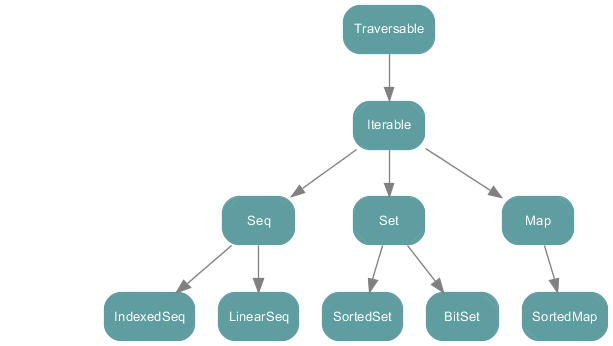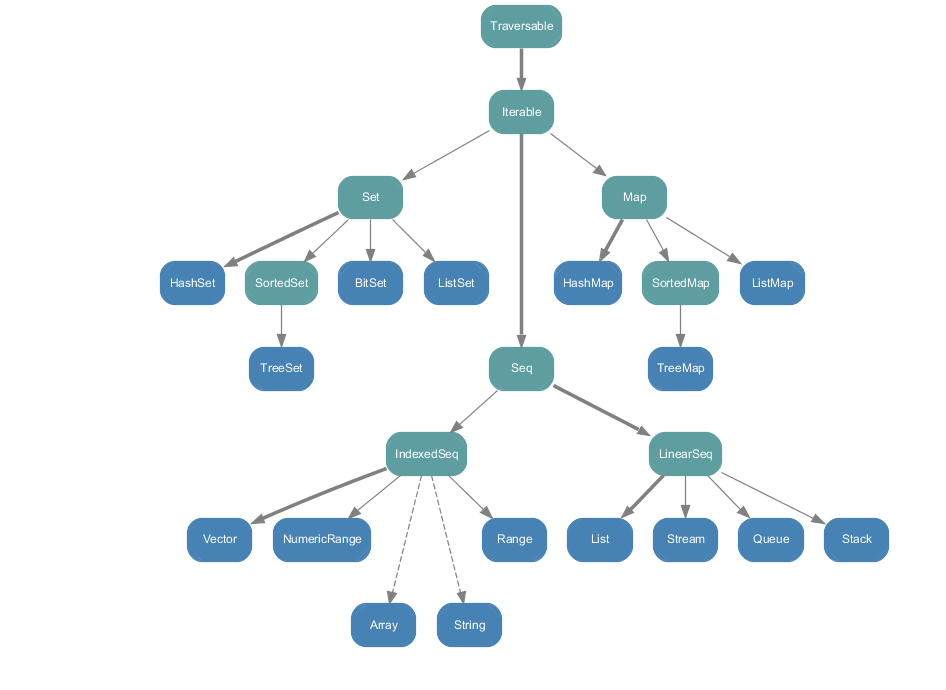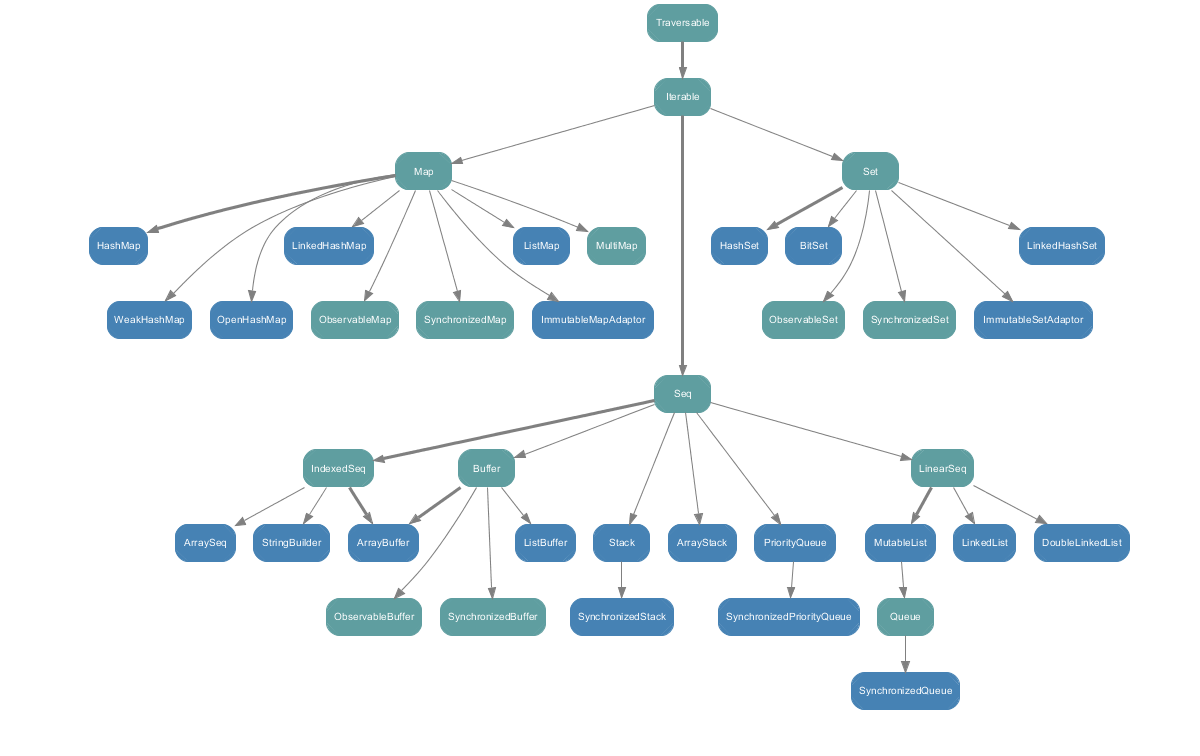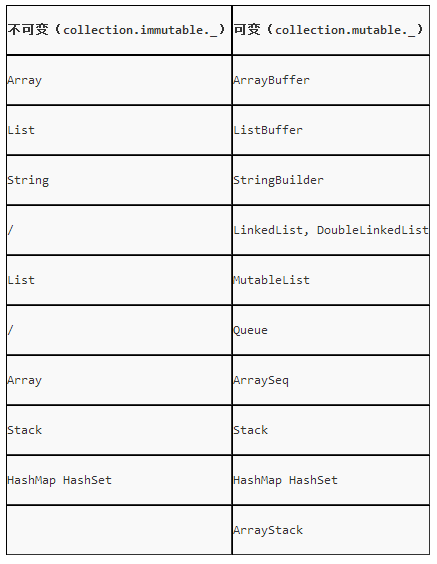Scala入門到精通——第四節 Set、Map、Tuple、佇列操作實戰
本節主要內容
- mutable、immutable集合
- Set操作實戰
- Map操作實戰
- Tuple操作實戰
- 佇列操作實戰
- 棧操作實戰
mutable、immutable集合
Scala collections systematically distinguish between mutable and immutable collections. A mutable collection can be updated or extended in place.
This means you can change, add, or remove elements of a collection as scala中所有的集合都來自於scala.collection包及其子包mutable, immutable當中
//scala.collection.immutable包中的集合絕對是不可變的,函數語言程式設計語言推崇使用immutable集合
A collection in package scala.collection.immutable is guaranteed to be immutable for everyone. Such a collection will never change after it is created.
Therefore, you can rely on the fact that accessing the same collection value repeatedly at different points in 在scala中,預設使用的都是immutable集合,如果要使用mutable集合,需要在程式中引入
import scala.collection.mutable
//由於immutable是預設匯入的,因此要使用mutable中的集合的話
//使用如下語句
scala> val mutableSet=mutable.Set(1,2,3)
mutableSet: scala.collection.mutable.Set[Int] = Set(1, 2, 3)
//不指定的話,建立的是immutable 集合
scala> val mutableSet=Set(1,2,3)
mutableSet: scala.collection.immutable.Set[Int] = Set(1, 2, 3)直接使用Set(1,2,3)建立的是immutable集合,這是因為當你不引入任何包的時候,scala會預設匯入以幾個包:
Predef物件中包含了Set、Map等的定義
scala集合類的層次結構:
scala.collection包中的集合類層次結構如下圖:

These are all high-level abstract classes or traits, which generally have mutable as well as immutable implementations.
scala.collection.immutable包中的類層次結構:
scala.collection.mutable包中的類層次結構:
可變集合與不可變集合對應關係:
Set操作實戰
1 Set(集)是一種不存在重複元素的集合,它與數學上定義的集合是對應的
//定義一個集合
//這裡使用的是mutable
scala> val numsSet=Set(3.0,5)
numsSet: scala.collection.mutable.Set[Double] = Set(5.0, 3.0)
//向集中新增一個元素,同前一講中的列表和陣列不一樣的是
//,Set在插入元素時並不保元素的順序
//預設情況下,Set的實現方式是HashSet實現方式,
//集中的元素通過HashCode值進行組織
scala> numsSet+6
res20: scala.collection.mutable.Set[Double] = Set(5.0, 6.0, 3.0)
//遍歷集
scala> for ( i <- res20 ) println(i)
5.0
6.0
3.0
//如果對插入的順序有著嚴格的要求,則採用scala.collection.mutalbe.LinkedHashSet來實現
scala> val linkedHashSet=scala.collection.mutable.LinkedHashSet(3.0,5)
linkedHashSet: scala.collection.mutable.LinkedHashSet[Double] = Set(3.0, 5.0)
scala> linkedHashSet+6
res26: scala.collection.mutable.LinkedHashSet[Double] = Set(3.0, 5.0, 6.0)Map操作實戰
Map是一種鍵值對的集合,一般將其翻譯為對映
//直接初始化
// ->操作符,左邊是key,右邊是value
scala> val studentInfo=Map("john" -> 21, "stephen" -> 22,"lucy" -> 20)
studentInfo: scala.collection.immutable.Map[String,Int] = Map(john -> 21, stephe
n -> 22, lucy -> 20)
//immutable不可變,它不具有以下操作
scala> studentInfo.clear()
<console>:10: error: value clear is not a member of scala.collection.immutable.M
ap[String,Int]
studentInfo.clear()
^
//建立可變的Map
scala> val studentInfoMutable=scala.collection.mutable.Map("john" -> 21, "stephe
n" -> 22,"lucy" -> 20)
studentInfoMutable: scala.collection.mutable.Map[String,Int] = Map(john -> 21, l
ucy -> 20, stephen -> 22)
//mutable Map可變,比如可以將其內容清空
scala> studentInfoMutable.clear()
scala> studentInfoMutable
res3: scala.collection.mutable.Map[String,Int] = Map()
//遍歷操作1
scala> for( i <- studentInfoMutable ) println(i)
(john,21)
(lucy,20)
(stephen,22)
//遍歷操作2
scala> studentInfoMutable.foreach(e=>
{val (k,v)=e; println(k+":"+v)}
)
john:21
lucy:20
stephen:22
//遍歷操作3
scala> studentInfoMutable.foreach(e=> println(e._1+":"+e._2))
john:21
lucy:20
stephen:22
//定義一個空的Map
scala> val xMap=new scala.collection.mutable.HashMap[String,Int]()
xMap: scala.collection.mutable.HashMap[String,Int] = Map()
//往裡面填充值
scala> xMap.put("spark",1)
res12: Option[Int] = None
scala> xMap
res13: scala.collection.mutable.HashMap[String,Int] = Map(spark -> 1)
//判斷是否包含spark字串
scala> xMap.contains("spark")
res14: Boolean = true
//-> 初始化Map,也可以通過 ("spark",1)這種方式實現(元組的形式)
scala> val xMap=scala.collection.mutable.Map(("spark",1),("hive",1))
xMap: scala.collection.mutable.Map[String,Int] = Map(spark -> 1, hive -> 1)
scala> "spark" -> 1
res18: (String, Int) = (spark,1)
//獲取元素
scala> xMap.get("spark")
res19: Option[Int] = Some(1)
scala> xMap.get("SparkSQL")
res20: Option[Int] = NoneOption,None,Some型別
Option、None、Some是scala中定義的型別,它們在scala語言中十分常用,因此這三個型別非學重要。
None、Some是Option的子類,它主要解決值為null的問題,在java語言中,對於定義好的HashMap,如果get方法中傳入的鍵不存在,方法會返回null,在編寫程式碼的時候對於null的這種情況通常需要特殊處理,然而在實際中經常會忘記,因此它很容易引起 NullPointerException異常。在Scala語言中通過Option、None、Some這三個類來避免這樣的問題,這樣做有幾個好處,首先是程式碼可讀性更強,當看到Option時,我們自然而然就知道它的值是可選的,然後變數是Option,比如Option[String]的時候,直接使用String的話,編譯直接通不過。
前面我們看到:
scala> xMap.get("spark")
res19: Option[Int] = Some(1)那要怎麼才能獲取到最終的結果呢,
//通過模式匹配得到最終的結果
scala> def show(x:Option[Int]) =x match{
| case Some(s) => s
| case None => “????”
| }
show: (x: Option[Int])Any
scala> show(xMap.get(“spark”))
res21: Any = 1
scala> show(xMap.get(“sparkSQL”))
res22: Any = ????
元組操作實戰
前面我們提到Map是鍵值對的集合,元組則是不同型別值的聚集
//元組的定義
scala> ("hello","china","beijing")
res23: (String, String, String) = (hello,china,beijing)
scala> ("hello","china",1)
res24: (String, String, Int) = (hello,china,1)
scala> var tuple=("Hello","China",1)
tuple: (String, String, Int) = (Hello,China,1)
//訪問元組內容
scala> tuple._1
res25: String = Hello
scala> tuple._2
res26: String = China
scala> tuple._3
res27: Int = 1
//通過模式匹配獲取元組內容
scala> val (first, second, third)=tuple
first: String = Hello
second: String = China
third: Int = 1
佇列操作實戰
//immutable queue
scala> var queue=scala.collection.immutable.Queue(1,2,3)
queue: scala.collection.immutable.Queue[Int] = Queue(1, 2, 3)
//出隊
scala> queue.dequeue
res38: (Int, scala.collection.immutable.Queue[Int]) = (1,Queue(2, 3))
//入隊
scala> queue.enqueue(4)
res40: scala.collection.immutable.Queue[Int] = Queue(1, 2, 3, 4)
//mutable queue
scala> var queue=scala.collection.mutable.Queue(1,2,3,4,5)
queue: scala.collection.mutable.Queue[Int] = Queue(1, 2, 3, 4, 5)
//入隊操作
scala> queue += 5
res43: scala.collection.mutable.Queue[Int] = Queue(1, 2, 3, 4, 5, 5)
//集合方式
scala> queue ++= List(6,7,8)
res45: scala.collection.mutable.Queue[Int] = Queue(1, 2, 3, 4, 5, 5, 6, 7, 8)
棧操作實戰
//mutable Stack
scala> import scala.collection.mutable.Stack
import scala.collection.mutable.Stack
//new 建立方式
scala> val stack = new Stack[Int]
stack: scala.collection.mutable.Stack[Int] = Stack()
//Apply建立方式
scala> val stack1=Stack(1,2,3)
stack1: scala.collection.mutable.Stack[Int] = Stack(1, 2, 3)
//出棧
scala> stack1.top
res55: Int = 1
//入棧
scala> stack.push(1)
res57: stack.type = Stack(1)
//入棧
scala> stack.push(2)
res58: stack.type = Stack(2, 1)
//出棧
scala> stack.top
res59: Int = 2
scala> stack
res60: scala.collection.mutable.Stack[Int] = Stack(2, 1)新增公眾微訊號,可以瞭解更多最新Spark、Scala相關技術資訊






